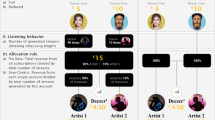Abstract
This paper considers the market for digital music. We claim that the combination of the MP3 format and peer-to-peer networks has made music non-excludable and this feature is essential for the understanding of the economics of the music market. We study optimal business models for selling non-excludable goods and show that despite promising theoretical results, adding just a slight uncertainty about the number of customers has significant negative implications for profitability. Indeed, as the average number of customers tends to infinity the average payment per customer converges to zero. Therefore, the music industry should concentrate on alternative ways of creating profit such as selling access to listeners, concerts, merchandise, ringtones etc.
Similar content being viewed by others
References
Bagnoli, M., & Lipman, B. L. (1989). Provision of public goods: Fully implementing the core through private contributions. Review of Economic Studies, 56, 583–601.
Bhattacharjee, S., Gopal, R. D., Lertwachara, K., Marsden, J. R., & Telang, R. (2007). The effect of digital sharing technologies on music markets: A survival analysis of albums on ranking charts. Management Science, 53, 1359–1374.
Boldrine, M., & Levine, D. (2002). The case against intellectual property. American Economic Review, 92, 209–212.
Conner, K. R., & Rumelt, R. P. (1991). Software piracy—an analysis of protection strategies. Management Science, 37, 125–139.
Crémer, J., & McLean, R. P. (1985). Optimal selling strategies under uncertainty for a discriminating monopolist when demands are interdependent. Econometrica, 53, 345–361.
Crémer, J., & McLean, R. P. (1988). Full extraction of the surplus in Bayesian and dominant strategy auctions. Econometrica, 56, 1247–1257.
DeFigueiredo, D. (2003). Unleashing the power of digital goods: enabling new business models for the music industry, unpublished manuscript.
Duchêne, A., Peitz, M., & Waelbroeck, P. (2005). Marketing digital mucic: Can DRM help? working paper EC-05-02, Telecom Paris.
Hong, J.-S., & Kim, J.-C. (2008). Competition with clone: and analysis of the role of illegal copy. Netnomics, 9, 87–94.
Mailath, G. J., & Postlewaite, A. (1990). Asymmetric information bargaining problems with many agents. Review of Economic Studies, 57, 351–367.
Novos, I. E., & Waldman, M. (1984). The effects of increased copyright protection: an analytic approach. Journal of Political Economy, 92, 236–246.
Oberholzer-Gee, F., & Strumpf, K. (2007). The effect of file sharing on record sales an empirical analysis. Journal of Political Economy, 115, 1–42.
Peitz, M., & Waelbroeck, P. (2005). An economists guide to digital music. CESIFO, 51,(2–3), 359–428.
Peitz, M., & Waelbroeck, P. (2006a). Piracy of digital products: A critical review of the theoretical literature. Information Economics and Policy, 18, 449–476.
Peitz, M., & Waelbroeck, P. (2006b). Why the music industry may gain from free downloading—the role of sampling. International Journal of Industrial Organization, 24, 907–913.
Pfahl, M. (2001). Giving away music to make money: Independent musicians on the Internet. http://firstmonday.org/issues/issue6_8/pfahl/index.html.
Takeyama, L. N. (1994). The welfare implications of unauthorized reproduction of intellectual property in the presence of demand network externalities. The Journal of Industrial Economics, 42, 155–166.
Feller, W. (1968). An introduction to probability theory and its application. Wiley.
Author information
Authors and Affiliations
Corresponding author
Rights and permissions
About this article
Cite this article
Hougaard, J.L., Tvede, M. Selling digital music: business models for public goods. Netnomics 11, 85–102 (2010). https://doi.org/10.1007/s11066-009-9047-0
Accepted:
Published:
Issue Date:
DOI: https://doi.org/10.1007/s11066-009-9047-0




